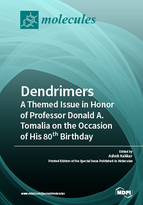Dendrimers: A Themed Issue in Honor of Professor Donald A. Tomalia on the Occasion of His 80th Birthday
A special issue of Molecules (ISSN 1420-3049).
Deadline for manuscript submissions: closed (5 March 2018) | Viewed by 110409
Special Issue Editor
Interests: nanostructures; soft nanoparticles; macromolecules; dendrimers; miktoarm polymers; telodendrimers; naked nanocarriers; metal nanoparticles; gold nanoshells; iron oxide nanoparticles; nanomedicine; drug delivery; diagnostics
Special Issues, Collections and Topics in MDPI journals
Special Issue Information
Dear Colleagues,
Dr. Donald A. Tomalia, one of the pioneers in the development of monodisperse and highly branched macromolecules, who coined the term “Dendrimers” in 1985 in reference to their tree like structure, has played a key role in establishing their place in polymer chemistry, and provided continued inspiration to many in expanding the scope and potential of these well-defined architectures. The divergent synthetic methodology to dendrimers, coupled with the convergent approach developed by Dr. Jean Fréchet, provided access to and an insight into the unique properties offered by these spherical macromolecules, which sparked an explosive growth of the dendrimer field. With excellent contributions of several leaders that followed, dendrimers have demonstrated potential and find applications in numerous areas including medicine, catalysis, sensors, etc.
“Molecules” is highly pleased to host a Themed Issue honoring Dr. Donald A. Tomalia for his outstanding achievements in advancing the field of dendrimers on the occasion of his 80th birthday.
Dr. Donald Tomalia obtained his B.A. in Chemistry from University of Michigan, subsequently joined Dow Chemical, and while there, completed his PhD in physical-organic chemistry from Michigan State University under the direction of Professor Harold Hart. His initial studies on cationic polymerization were recognized by international industrial awards for creative research in 1978 and 1986, and followed by another similar award in 1991 for the discovery of dendrimers. He has received several other accolades including Leonardo da Vinci award (1996) and Society of Polymer Science Japan award (2003) for discovering dendritic polymers. He worked at Michigan Molecular Institute from 1990-1999 in the capacity as Professor and Director. He currently serves as Adjunct Professor in the Department of Chemistry at the University of Pennsylvania. He co-founded Dendritech in 1992, the first supplier of commercially available dendrimers, founded Dendritech Nanotechnologies in 2002 in collaboration with Starpharma, and is currently the founder and CEO of Nanosynthons. Dr. Tomalia has authored/co-authored more than 200 peer-reviewed publications including books on dendrimers, and holds more than 100 dendrimer-based patents in the USA. He is an Associate Editor of Journal of Nanoparticle Research (Springer), and on the Honorary Editorial Board of Nanomedicine: Nanotechnology, Biology and Medicine (Elsevier). He is a Faculty Member in Faculty 1000 Prime.
Molecules invites scientists to submit original contributions to “Dendrimers: A Themed Issue in Honor of Professor Donald A. Tomalia on the Occasion of his 80th Birthday”, and join us in collectively congratulating him for his outstanding accomplishments.
Prof. Dr. Ashok Kakkar
Guest Editor
Manuscript Submission Information
Manuscripts should be submitted online at www.mdpi.com by registering and logging in to this website. Once you are registered, click here to go to the submission form. Manuscripts can be submitted until the deadline. All submissions that pass pre-check are peer-reviewed. Accepted papers will be published continuously in the journal (as soon as accepted) and will be listed together on the special issue website. Research articles, review articles as well as short communications are invited. For planned papers, a title and short abstract (about 100 words) can be sent to the Editorial Office for announcement on this website.
Submitted manuscripts should not have been published previously, nor be under consideration for publication elsewhere (except conference proceedings papers). All manuscripts are thoroughly refereed through a single-blind peer-review process. A guide for authors and other relevant information for submission of manuscripts is available on the Instructions for Authors page. Molecules is an international peer-reviewed open access semimonthly journal published by MDPI.
Please visit the Instructions for Authors page before submitting a manuscript. The Article Processing Charge (APC) for publication in this open access journal is 2700 CHF (Swiss Francs). Submitted papers should be well formatted and use good English. Authors may use MDPI's English editing service prior to publication or during author revisions.
Keywords
- Dendrimers
- Dendrons
- Hyperbranched macromolecules
- Divergent and convergent methodologies
- Dendrimer conjugates
- Metallodendrimers
- Dendrimers in biomedicine
- Light harvesting dendrimers
- Dendrimers-based catalysis
- Supramolecular dendrimers
- Dendrimers for drug and gene delivery
- Dendrimer-based sensors
- Dendrimers as blood substitutes







